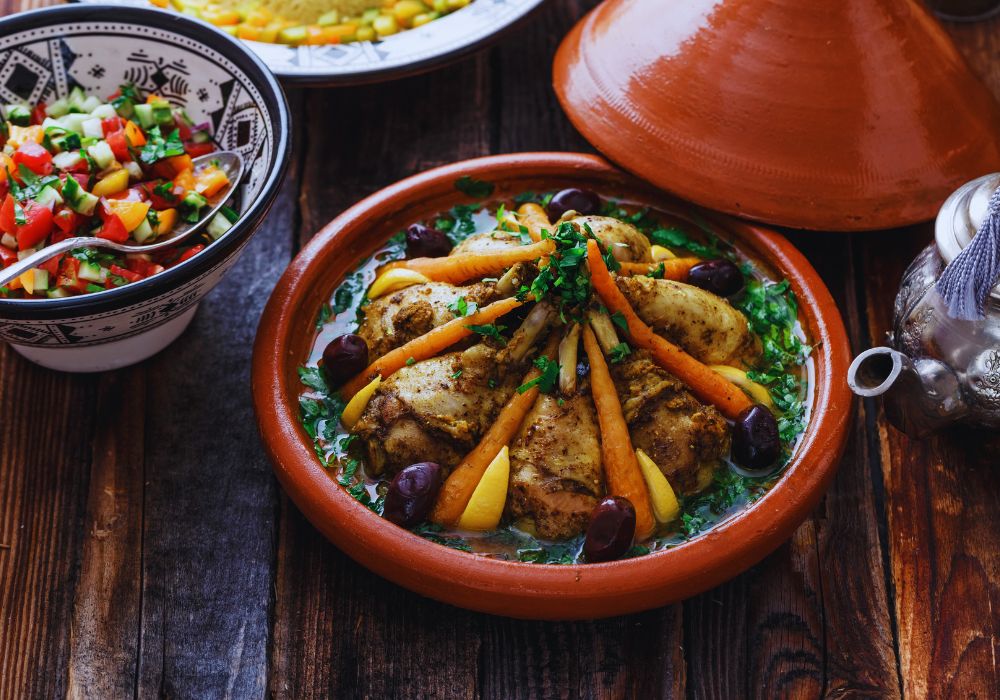Embark on a tantalizing journey as we delve into the heart of Morocco’s rich culinary tapestry in our blog post, ‘Feast Your Senses: Drinks & Food in Morocco Unveiled.’ From aromatic spices to savory tagines and the ritual of mint tea, join us on a gastronomic odyssey that explores the delectable delights and cultural significance of Moroccan cuisine. This immersive exploration promises to awaken your taste buds and offer a flavorful insight into the vibrant world of food in Morocco, where every dish tells a story and every meal is a celebration of tradition.
Moroccan Gastronomy: Diving Deep into the Rich Tapestry of Food in Morocco
Basic Moroccan meals may begin with a thick, very filling soup – most often the spicy, bean and pasta Harira, Alternatively, you might start with a salad (often very finely chopped), or have this as a side dish with your main course, typically a plateful of kebabs – either brochettes (small pieces of lamb on a skewer) or Kefta, (minced lamb). A few hole-in-the-wall places specialize in soup, which they sell by the bowlful all day long – such places are usually indicated by a pile of soup bowls at the front, As well as Harira, and especially for breakfast, some places sell a thick pea soup called Bisara, topped with olive oil.
Another dish you’ll find everywhere is a Tajine, essentially a stew, steam-cooked slowly in an earthenware dish with a conical earthenware lid. Classic Tagines include lamb or mutton with prunes and almonds, or chicken with olives and lemon. Less often, you may get fish or vegetable tagines, or a tagine of meatballs topped with eggs.
Drinks & Food in Morocco: Restaurant meals
Restaurants usually offer fish, particularly on the coast, lamb or mutton, usually in a tagine, and chicken, either spit-roasted or in a tagine with lemon and olives. You will sometimes find pastille too, a succulent pigeon or chicken pie, prepared with filo pastry dusted with sugar and cinnamon; it is a particular specialty of Fez. And of course, there is Couscous, the most famous Moroccan dish; Berber in origin it’s a huge bowl of steamed semolina piled high with vegetables and mutton, chicken, or occasionally fish.
At festivals, which are always good for interesting food, and at the fancy tourist restaurants, you may also come across Mechoui-roast lamb which may even take the form of a whole sheep roasted on a spit. In Marrakech particularly, another specialty is Tanjia, which is jugged beef or lamb, cooked very slowly in the embers of a hammam furnace.
Dessert may consist of a pastry, a crème caramel, or possibly yogurt, which is often –even in cheap places, the restaurant’s own. Otherwise, you may get fruits, either oranges or perhaps, fruit salad.
Food in Morocco: Eating the Moroccan Way
Eating in local cafes, or if invited to a home, you may find yourself using your hands rather than a knife and a fork. Muslims eat only with the right hand, and you are advised to do likewise. Hold the bread between the fingers and use your thumb as a scoop; it’s often easier to discard the soft center of the bread and to use the crust only – as you will see many Moroccans do. Eating at a communal plate at someone’s home, it is polite to take only what is immediately in front of you, unless specifically offered a piece of meat by the host.
Vegetarian eating
Vegetarianism is met with little comprehension in most of Morocco, though restaurants in some places are becoming aware that tourists may be vegetarian, and many places do now offer a meat-free tajine or couscous. Meat-free Pizzas are also available in large towns. If you are a very strict vegetarian or vegan, it may be worth bringing some basic provisions (such as yeast extract, peanut butter, and veggie stock cubes), otherwise, we kindly urge you to inform your guide about your eating preferences so he/she may tell each restaurant you’ll eat at.
Tea, coffee and soft drinks
The national drink is mint tea ‘Moroccan Whisky’ as some Moroccans call it. Chinese gunpowder green tea flavored with sprigs of mint and sweetened with a large amount of sugar, often from a sugar loaf (you can ask for it with little or no sugar). In winter, Moroccans often add wormwood (Chiba in Arabic) to their tea to keep out the cold.
Also common at cafes and street stalls is a range of wonderful freshly squeezed juices: orange juice (some of it contains sugar; however you may ask to have it without). Almond milk, banana juice, and apple juices are also available. Also common is Panaché, a mixed fruit milkshake often featuring raisins.
Moroccan tap water is usually chlorinated and is safe to drink, but you ought to stick to bottled mineral water. Coffee is best in French-style cafés, either (black) cassé ( with drops of milk) or lait ( with a large amount of milk).
Alcoholic Drinks
As an Islamic nation, Morocco gives drinking alcohol a low profile, and it is generally not possible to buy it in the city of Medinas. Ordinary bars are very much all-male preserves, in which women may feel uneasy, but up-market bars especially in Marrakech or Casablanca or in classified ( rated from 3 to 5 stars) hotels are usually fine for both women and men to drink wine or beer.
Moroccan wines can be palatable enough if a little heavy for drinking without a meal. The best is the pinkish-red Clairet de Meknes, made purposefully light in French claret style. Beauvallon is another good one but usually preserved for export. Other varieties recommended to give a try are the strong red Cabernet, Ksar, Gurrouane, and Siraoua.

